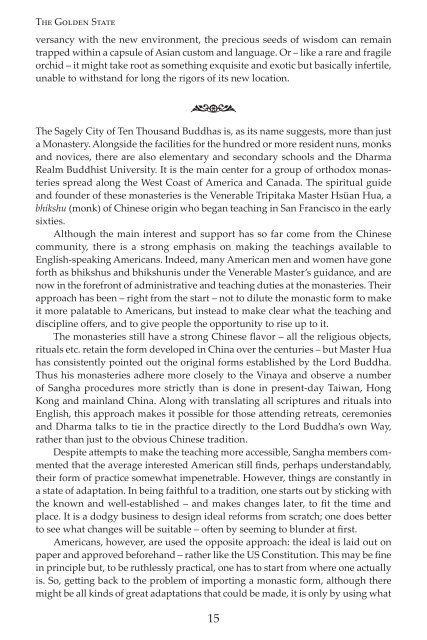Rugged Interdependency - Amaravati Buddhist Monastery
Rugged Interdependency - Amaravati Buddhist Monastery
Rugged Interdependency - Amaravati Buddhist Monastery
- No tags were found...
You also want an ePaper? Increase the reach of your titles
YUMPU automatically turns print PDFs into web optimized ePapers that Google loves.
The Golden Stateversancy with the new environment, the precious seeds of wisdom can remaintrapped within a capsule of Asian custom and language. Or – like a rare and fragileorchid – it might take root as something exquisite and exotic but basically infertile,unable to withstand for long the rigors of its new location.•The Sagely City of Ten Thousand Buddhas is, as its name suggests, more than justa <strong>Monastery</strong>. Alongside the facilities for the hundred or more resident nuns, monksand novices, there are also elementary and secondary schools and the DharmaRealm <strong>Buddhist</strong> University. It is the main center for a group of orthodox monasteriesspread along the West Coast of America and Canada. The spiritual guideand founder of these monasteries is the Venerable Tripitaka Master Hsüan Hua, abhikshu (monk) of Chinese origin who began teaching in San Francisco in the earlysixties.Although the main interest and support has so far come from the Chinesecommunity, there is a strong emphasis on making the teachings available toEnglish-speaking Americans. Indeed, many American men and women have goneforth as bhikshus and bhikshunis under the Venerable Master’s guidance, and arenow in the forefront of administrative and teaching duties at the monasteries. Theirapproach has been – right from the start – not to dilute the monastic form to makeit more palatable to Americans, but instead to make clear what the teaching anddiscipline offers, and to give people the opportunity to rise up to it.The monasteries still have a strong Chinese flavor – all the religious objects,rituals etc. retain the form developed in China over the centuries – but Master Huahas consistently pointed out the original forms established by the Lord Buddha.Thus his monasteries adhere more closely to the Vinaya and observe a numberof Sangha procedures more strictly than is done in present-day Taiwan, HongKong and mainland China. Along with translating all scriptures and rituals intoEnglish, this approach makes it possible for those attending retreats, ceremoniesand Dharma talks to tie in the practice directly to the Lord Buddha’s own Way,rather than just to the obvious Chinese tradition.Despite attempts to make the teaching more accessible, Sangha members commentedthat the average interested American still finds, perhaps understandably,their form of practice somewhat impenetrable. However, things are constantly ina state of adaptation. In being faithful to a tradition, one starts out by sticking withthe known and well-established – and makes changes later, to fit the time andplace. It is a dodgy business to design ideal reforms from scratch; one does betterto see what changes will be suitable – often by seeming to blunder at first.Americans, however, are used the opposite approach: the ideal is laid out onpaper and approved beforehand – rather like the US Constitution. This may be finein principle but, to be ruthlessly practical, one has to start from where one actuallyis. So, getting back to the problem of importing a monastic form, although theremight be all kinds of great adaptations that could be made, it is only by using what15
















